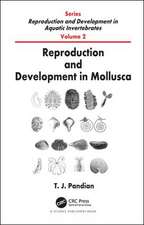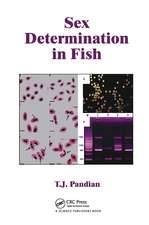Reproduction and Development in Minor Phyla: Reproduction and Development in Aquatic Invertebrates
Autor T. J. Pandianen Limba Engleză Paperback – 29 mai 2023
| Toate formatele și edițiile | Preț | Express |
|---|---|---|
| Paperback (1) | 436.14 lei 6-8 săpt. | |
| CRC Press – 29 mai 2023 | 436.14 lei 6-8 săpt. | |
| Hardback (1) | 897.38 lei 6-8 săpt. | |
| CRC Press – 14 mai 2021 | 897.38 lei 6-8 săpt. |
Preț: 436.14 lei
Nou
Puncte Express: 654
Preț estimativ în valută:
83.46€ • 87.54$ • 69.48£
83.46€ • 87.54$ • 69.48£
Carte tipărită la comandă
Livrare economică 01-15 aprilie
Preluare comenzi: 021 569.72.76
Specificații
ISBN-13: 9780367523367
ISBN-10: 0367523361
Pagini: 320
Ilustrații: 48 Tables, black and white; 99 Illustrations, black and white
Dimensiuni: 156 x 234 x 17 mm
Greutate: 0.45 kg
Ediția:1
Editura: CRC Press
Colecția CRC Press
Seria Reproduction and Development in Aquatic Invertebrates
ISBN-10: 0367523361
Pagini: 320
Ilustrații: 48 Tables, black and white; 99 Illustrations, black and white
Dimensiuni: 156 x 234 x 17 mm
Greutate: 0.45 kg
Ediția:1
Editura: CRC Press
Colecția CRC Press
Seria Reproduction and Development in Aquatic Invertebrates
Cuprins
General Introduction. AORGANOMORPHA. Placozoa. Mesozoa. Myxozoa. ACOELOMORPHA. Loricifera. Cycliophora. Nemertea. Gnathostomulida. PSEUDOCOELOMATA. Rotifera. Gastrotricha. Kinorhyncha. Nematoda. Nematomorpha. Acanthocephala. SCHIZOCOELOMATA: HEMOCOELOMATA. Priapulida. Sipuncula. Echiura. Tardigrada. Onychophora. Penastomida. SCHIZOCOELOMATA: LOPHOPHORATA. Entoprocta. Phoronida. Bryozoa. Brachiopoda. EUCOELOMATES. Chaetognatha. New Findings and Highlights. References. Author Index. Species Index. Subject Index.
Notă biografică
T. J. Pandian, M.Sc., Ph.D. (Madras), Dr. rer. nat. (Kiel, Germany), D.Sc. (CIFE, Mumbai) is 80 +, recipient of the Bhatnagar Prize, the highest award for a scientist in India, Naga International Prize (Philippines) and one of the ten National Professorships in the country. Elected to all academies of India and Trieste, Italy, he has served as Editor/Editorial Board Member of leading international journals. During the last ten years, he has single handedly authored ten volumes published by CRC Press, USA.
Recenzii
"Author provides an exciting comprehensive compilation of all the groups: one that offers a refreshing insightful synopsis of reproduction and development in all minor phyla animals."
— Robert L. Wallace, Rotifer News 38, January 2023
— Robert L. Wallace, Rotifer News 38, January 2023
Descriere
This book brings to light for the first time many interesting features in 25 minor phyletic invertebrates without being constrained by phylogenetic considerations. Relation between coelom type and regeneration is elaborated.














